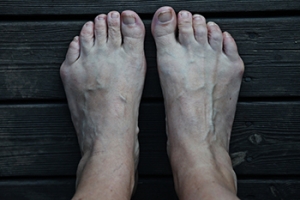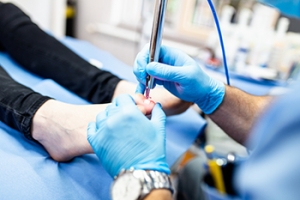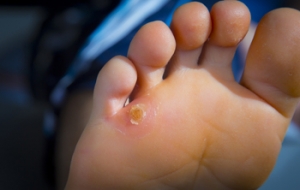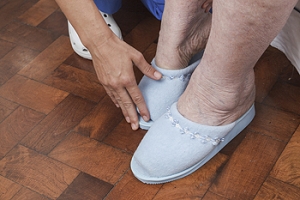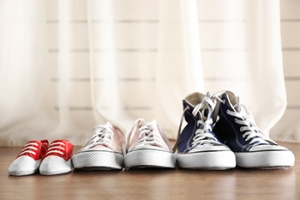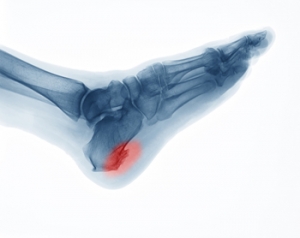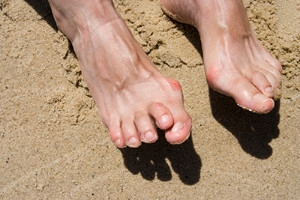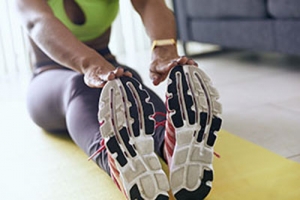Super User
What Is a Bunionette?
 Bunions appear as a bony lump at the main joint of the big toe when the big toe turns towards the other toes. A Tailor’s bunion, or bunionette, is the same thing but occurs at the base of the little toe. Tailor’s bunions are often a result of a faulty mechanical structure. As the little toe shifts inwards, the metatarsal bone begins to stick outwards. Tailor’s bunions are often indicated by redness, swelling, and pain, and they usually become irritated by shoes that are too narrow in the toes. Patients who believe that they have a Tailor’s bunion should consult with a podiatrist for a proper treatment. Nonsurgical treatment options include shoe modifications, padding, icing, orthotics, or injection therapy. In more severe cases, a podiatrist may need to perform surgery on the bunionette.
Bunions appear as a bony lump at the main joint of the big toe when the big toe turns towards the other toes. A Tailor’s bunion, or bunionette, is the same thing but occurs at the base of the little toe. Tailor’s bunions are often a result of a faulty mechanical structure. As the little toe shifts inwards, the metatarsal bone begins to stick outwards. Tailor’s bunions are often indicated by redness, swelling, and pain, and they usually become irritated by shoes that are too narrow in the toes. Patients who believe that they have a Tailor’s bunion should consult with a podiatrist for a proper treatment. Nonsurgical treatment options include shoe modifications, padding, icing, orthotics, or injection therapy. In more severe cases, a podiatrist may need to perform surgery on the bunionette.
If you are suffering from bunions, contact one of our podiatrists of Piedmont Podiatry Associates. Our doctors can provide the care you need to keep you pain-free and on your feet.
What Is a Bunion?
A bunion is formed of swollen tissue or an enlargement of boney growth, usually located at the base joint of the toe that connects to the foot. The swelling occurs due to the bones in the big toe shifting inward, which impacts the other toes of the foot. This causes the area around the base of the big toe to become inflamed and painful.
Why Do Bunions Form?
Genetics – Susceptibility to bunions are often hereditary
Stress on the feet – Poorly fitted and uncomfortable footwear that places stress on feet, such as heels, can worsen existing bunions
How Are Bunions Diagnosed?
Doctors often perform two tests – blood tests and x-rays – when trying to diagnose bunions, especially in the early stages of development. Blood tests help determine if the foot pain is being caused by something else, such as arthritis, while x-rays provide a clear picture of your bone structure to your doctor.
How Are Bunions Treated?
- Refrain from wearing heels or similar shoes that cause discomfort
- Select wider shoes that can provide more comfort and reduce pain
- Anti-inflammatory and pain management drugs
- Orthotics or foot inserts
- Surgery
If you have any questions, please feel free to contact one of our offices located in Greenville, and Easley, SC . We offer the newest diagnostic and treatment technologies for all your foot care needs.
How Laser Treatment Works to Kill Toenail Fungus
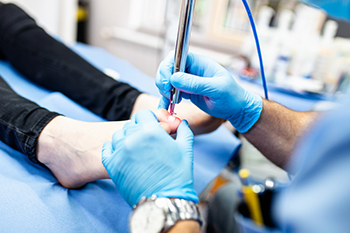 Fungal nail infections can be caused by many different types of fungi (yeasts or molds) that live in the environment. Small cracks in your nail or the surrounding skin can allow these germs to enter and cause an infection. Because nails get brittle with age, older adults are more prone to developing a fungal nail infection, as are those with a weakened immune system, circulation problems, diabetes, athlete’s foot, or who have recently experienced a nail injury or nail surgery. Laser therapy can often be effective in the treatment of this resilient fungal infection by targeting a laser light beam through the nail to kill the fungi without affecting the healthy parts of the nail and surrounding skin. If you have toenail fungus, contact a podiatrist to see if laser therapy treatment is right for you.
Fungal nail infections can be caused by many different types of fungi (yeasts or molds) that live in the environment. Small cracks in your nail or the surrounding skin can allow these germs to enter and cause an infection. Because nails get brittle with age, older adults are more prone to developing a fungal nail infection, as are those with a weakened immune system, circulation problems, diabetes, athlete’s foot, or who have recently experienced a nail injury or nail surgery. Laser therapy can often be effective in the treatment of this resilient fungal infection by targeting a laser light beam through the nail to kill the fungi without affecting the healthy parts of the nail and surrounding skin. If you have toenail fungus, contact a podiatrist to see if laser therapy treatment is right for you.
MLS Laser Therapy is a successful alternative for treating any pain you may be experiencing related to certain podiatric conditions. If you are interested in MLS Laser Therapy, consult with one of our podiatrists from Piedmont Podiatry Associates. Our doctors will assess your condition and provide you with quality foot and ankle treatment.
MLS Laser Therapy
Multiwave Locked System (MLS) Laser Therapy is a patented, FDA-cleared technology that helps relieve pain and inflammation from a number of podiatric conditions, including:
- Heel Pain
- Plantar Fasciitis
- Sports Injuries
- Wounds
- Achilles Tendonitis
- Arthritis
- Neuropathy
- Neuromas
MLS Laser Therapy is an ideal alternative to surgery and prescription medication, as it has no negative side effects and encourages accelerated healing. Among its many clinical benefits, MLS Laser Therapy also:
- Reduces swelling due to bruising or inflammation
- Blocks pain
- Reduces formation of scar tissue
- Improves nerve function
If you have any questions, please feel free to contact one of our offices located in Greenville, and Easley, SC . We offer the newest diagnostic and treatment technologies for all your foot care needs.
Is It a Corn, or a Callus?
 Corns and calluses are similar in that they are both patches of dry skin that can appear on the feet in response to friction. Corns are small lumps of hardened skin that resemble a corn kernel in appearance. They often form on the soles of the feet or in between the toes and can be yellowish in color. Calluses are larger patches of rough, thick skin that often appear on the balls or heels of the feet. While both corns and calluses can usually be treated with conservative methods such as wearing wider, more comfortable shoes, moisturizing the skin, and wearing thicker, cushioned socks, certain cases may require medical intervention. If you have diabetes, circulatory problems, notice signs of infection such as bleeding or pus discharge, or are in severe pain, please seek the care of a podiatrist.
Corns and calluses are similar in that they are both patches of dry skin that can appear on the feet in response to friction. Corns are small lumps of hardened skin that resemble a corn kernel in appearance. They often form on the soles of the feet or in between the toes and can be yellowish in color. Calluses are larger patches of rough, thick skin that often appear on the balls or heels of the feet. While both corns and calluses can usually be treated with conservative methods such as wearing wider, more comfortable shoes, moisturizing the skin, and wearing thicker, cushioned socks, certain cases may require medical intervention. If you have diabetes, circulatory problems, notice signs of infection such as bleeding or pus discharge, or are in severe pain, please seek the care of a podiatrist.
If you have any concerns regarding your feet and ankles, contact one of our podiatrists of Piedmont Podiatry Associates. Our doctors will treat your foot and ankle needs.
Corns: What Are They? and How Do You Get Rid of Them?
Corns can be described as areas of the skin that have thickened to the point of becoming painful or irritating. They are often layers and layers of the skin that have become dry and rough, and are normally smaller than calluses.
Ways to Prevent Corns
There are many ways to get rid of painful corns such as wearing:
- Well-fitting socks
- Comfortable shoes that are not tight around your foot
- Shoes that offer support
Treating Corns
Treatment of corns involves removing the dead skin that has built up in the specific area of the foot. Consult with Our doctors to determine the best treatment option for your case of corns.
If you have any questions please feel free to contact one of our offices located in Greenville, and Easley, SC . We offer the newest diagnostic and treatment technologies for all your foot and ankle needs.
Understanding Corns and Calluses
Corns and Calluses are both hardened layers of thickened skin that develop because of friction. Both ailments are typically found on the feet and may be unsightly. Although they have similarities, corns and calluses are different from each other.
Some causes of corns and calluses may be wearing ill-fitting shoes and not wearing socks. If you wear tight shoes, your feet will constantly be forced to rub against the shoes, causing friction. If you fail to wear socks, you are also causing your feet to endure excess friction.
There are some signs that may help you determine whether you have one of these two conditions. The first symptom is a thick, rough area of skin. Another common symptom is a hardened, raised bump on the foot. You may also experience tenderness or pain under the skin in addition to flaky, dry, or waxy skin.
There are also risk factors that may make someone more prone to developing corns and calluses. If you are already dealing with bunions or hammertoe, you may be more vulnerable to having corns and calluses as well. Other risk factors are foot deformities such as bone spurs, which can cause constant rubbing inside the shoe.
Corns tend to be smaller than calluses and they usually have a hard center surrounded by inflamed skin. They also tend to develop on the parts of the body that don’t bear as much weight such as the tops and sides of toes. Corns may also be painful for those who have them. On the other hand, calluses are rarely painful. These tend to develop on the bottom of the feet and may vary in size and shape.
Fortunately, most people only need treatment for corns and calluses if they are experiencing discomfort. At home treatments for corns and calluses should be avoided, because they will likely lead to infection. If you have either of these ailments it is advised that you consult with your podiatrist to determine the best treatment option for you.
How You Walk as an Older Adult Matters
 Keeping your body as strong as possible as you age goes a long way in helping you to maintain proper balance and reducing the risk of falling or adding undue stress on certain parts of your body. A podiatrist can do a physical examination of you and also conduct a gait analysis—which assesses the mechanics of how you walk and detects any irregularities which may negatively affect your balance and stride. Certain exercises, or specific treatments and therapies to correct gait abnormalities may be part of your wellness plan. With the help of a podiatrist, you can take the right steps in improving balance and strengthening muscles in the feet and legs to help you stay independent and mobile for as long as possible.
Keeping your body as strong as possible as you age goes a long way in helping you to maintain proper balance and reducing the risk of falling or adding undue stress on certain parts of your body. A podiatrist can do a physical examination of you and also conduct a gait analysis—which assesses the mechanics of how you walk and detects any irregularities which may negatively affect your balance and stride. Certain exercises, or specific treatments and therapies to correct gait abnormalities may be part of your wellness plan. With the help of a podiatrist, you can take the right steps in improving balance and strengthening muscles in the feet and legs to help you stay independent and mobile for as long as possible.
If you need your feet checked, contact one of our podiatrists of Piedmont Podiatry Associates. Our doctors will attend to all of your foot and ankle needs and provide you with quality treatment.
Geriatrics and Podiatry
When people age, some common issues that may occur are bone density loss, dry skin, poor circulation, and rough brittle nails. These issues may also affect your foot health if the necessary steps are not taken to alleviate the problems.
It is important to take care of your feet because feet that are injured or diseased can affect your overall health. Having painful feet hinders your ability to do daily activities or may decrease your willingness to do the things that you need to do.
Visiting Your Geriatrician
As we age, health problems become more likely, so it is essential to visit your doctor for check-ups to ensure that you are doing the best you can to take care of your health. It is recommended to check your feet frequently for any possible cuts, bruises, swelling, corns or any other irregularities.
Taking Care of Elderly Feet
Cracked or dry feet can be treated by applying moisturizer often. It is also important not to wear old socks because the older the sock is, the higher the possibility there will be that there is bacteria there. Wear fresh socks and make sure they fit properly.
Proper foot health means that you can have a more active lifestyle and you will not be bogged down by pain. Foot health also leads to good circulation, which is paramount for overall health.
If you have any questions, please feel free to contact one of our offices located in Greenville, and Easley, SC . We offer the newest diagnostic tools and technology to treat your foot and ankle needs.
Do My Shoes Fit Properly?
 Wearing the right shoe size can help protect your feet from a variety of foot related issues and injuries. Shoes should cushion and support the foot, feel comfortable, and fit properly. There are some important tips to remember to achieve the perfect fit. If you are participating in physical activities, it is important to purchase shoes that are made and designed for your type of activity, such as walking shoes, running shoes, or even hiking boots. Because our feet are at their largest towards the end of the day, it is suggested to have them measured in the afternoon or evening. Ask a sales person for help to ensure you use the brannock device correctly. Make sure the toes can be wiggled while wearing the shoes and it is also suggested to wear the socks you intend to wear with the shoes. Additionally, make sure the shoes are comfortable when walking around the store, and avoid shoes that are made with plastic or have a narrow toe box. If you have questions or need help making sure your shoes fit properly, please seek the advice of a podiatrist.
Wearing the right shoe size can help protect your feet from a variety of foot related issues and injuries. Shoes should cushion and support the foot, feel comfortable, and fit properly. There are some important tips to remember to achieve the perfect fit. If you are participating in physical activities, it is important to purchase shoes that are made and designed for your type of activity, such as walking shoes, running shoes, or even hiking boots. Because our feet are at their largest towards the end of the day, it is suggested to have them measured in the afternoon or evening. Ask a sales person for help to ensure you use the brannock device correctly. Make sure the toes can be wiggled while wearing the shoes and it is also suggested to wear the socks you intend to wear with the shoes. Additionally, make sure the shoes are comfortable when walking around the store, and avoid shoes that are made with plastic or have a narrow toe box. If you have questions or need help making sure your shoes fit properly, please seek the advice of a podiatrist.
Getting the right shoe size is an important part of proper foot health. Seek the assistance of one of our podiatrists from Piedmont Podiatry Associates. Our doctors will provide the care you need to keep you pain-free and on your feet.
Getting the Right Shoe Size
There are many people who wear shoes that are the incorrect size, negatively affecting their feet and posture. Selecting the right shoes is not a difficult process, so long as you keep several things in mind when it comes to choosing the right pair.
- When visiting the shoe store, use the tools available to measure your foot.
- Be sure there is ‘wiggle room’. There should be about an inch between your toes and the tip of your shoes.
- Do not always assume you are the same size, as manufacturers run differently.
- Purchase shoes later in the day, as your feet swell as the day progresses.
- If a shoe is not comfortable, it is not suitable. Most shoes can’t be ‘broken in’, and comfort should be the ultimate goal when it comes to choosing the right pair of shoes
As our feet hold our body weight and keep us moving, it is important to treat them right. Picking the right pair of shoes can provide your feet comfort and mobility without pain.
If you have any questions, please feel free to contact one of our offices located in Greenville, and Easley, SC . We offer the newest diagnostic and treatment technologies for all your foot care needs.
Getting the Right Shoe Size
If you want to ensure the long-term health of your feet, you should choose the right pair of shoes to wear on an everyday basis. Poorly fitting shoes will not only be uncomfortable, but they may also cause foot pain and unwanted foot conditions. When looking for a new pair of shoes, there are certain factors you should look for.
One of the most crucial tips you can follow is to always try shoes on in the afternoon. It is normal for feet to swell throughout the day, which means your shoe size may be different in the morning compared to what it is at night. To be safe, you should go with the slightly bigger size to ensure that your feet have enough room within your shoes.
Another rule is to never buy shoes that are too tight (Many people buy shoes that are too tight for their feet and expect the shoes to stretch out). If you are looking for a pair of running sneakers, you can go to a specialty running shoe store to have your feet properly sized. When you purchase shoes in-store, walk around in them to make sure the shoes you are going to buy fit you properly. Take some time to make sure the shoes are comfortable for your feet
The upper section of your shoe should be made from a softer, more flexible material. The material that makes up the shoe should not be slippery. Arch support should be a key factor in the decision-making process for shoes. Arch support is crucial because it will prevent the arches in your feet from collapsing. If your arches collapse, the plantar fascia may begin to stretch out which could lead to plantar fasciitis.
Many problematic foot conditions may be prevented by wearing properly fitting shoes. Some of these unwanted conditions are bunions, corns, calluses, pain, stress fractures, and plantar fasciitis. If you are suffering from any of these ailments you may want to speak with your podiatrist.
Stretching the Feet May Help Heel Spurs
 A heel spur is defined as a bony growth that gradually develops on the back or bottom of the heel bone. It can cause severe pain and discomfort, and it may even be difficult to walk. A heel spur can be caused by arthritis, tendonitis, or due to a heel fracture. Mild relief may be found when the affected foot is rested and pain medication for inflammation is taken. Additionally, it is beneficial to perform specific stretches that may help to strengthen the overall foot. If you have heel pain, it may be indicative of a heel spur. It is strongly suggested that you speak with a podiatrist for a proper diagnosis and to determine what the best treatment is for you.
A heel spur is defined as a bony growth that gradually develops on the back or bottom of the heel bone. It can cause severe pain and discomfort, and it may even be difficult to walk. A heel spur can be caused by arthritis, tendonitis, or due to a heel fracture. Mild relief may be found when the affected foot is rested and pain medication for inflammation is taken. Additionally, it is beneficial to perform specific stretches that may help to strengthen the overall foot. If you have heel pain, it may be indicative of a heel spur. It is strongly suggested that you speak with a podiatrist for a proper diagnosis and to determine what the best treatment is for you.
Heel spurs can be incredibly painful and sometimes may make you unable to participate in physical activities. To get medical care for your heel spurs, contact one of our podiatrists from Piedmont Podiatry Associates. Our doctors will do everything possible to treat your condition.
Heels Spurs
Heel spurs are formed by calcium deposits on the back of the foot where the heel is. This can also be caused by small fragments of bone breaking off one section of the foot, attaching onto the back of the foot. Heel spurs can also be bone growth on the back of the foot and may grow in the direction of the arch of the foot.
Older individuals usually suffer from heel spurs and pain sometimes intensifies with age. One of the main condition's spurs are related to is plantar fasciitis.
Pain
The pain associated with spurs is often because of weight placed on the feet. When someone is walking, their entire weight is concentrated on the feet. Bone spurs then have the tendency to affect other bones and tissues around the foot. As the pain continues, the feet will become tender and sensitive over time.
Treatments
There are many ways to treat heel spurs. If one is suffering from heel spurs in conjunction with pain, there are several methods for healing. Medication, surgery, and herbal care are some options.
If you have any questions feel free to contact one of our offices located in Greenville, and Easley, SC . We offer the latest in diagnostic and treatment technology to meet your needs.
Read more about Heel SpursHammertoe Affects Toe Joints
 The foot condition that is known as hammertoe is often noticeable, and easily diagnosed. It typically affects the middle joints of the second or third toe, causing the joint to bend upward and the toes to bend downward. This condition often develops gradually due to genetic factors and from wearing shoes that do not have adequate room for the toes to move freely in. It is helpful to wear a larger size shoe that can accommodate the hammertoe, and mild relief may be found when a protective pad is worn over the affected joint. Corns may form on the top of the joint from friction that can come from the shoes that are worn. If you have hammertoe, it is strongly suggested that you are under the care of a podiatrist who can properly diagnose and treat this condition.
The foot condition that is known as hammertoe is often noticeable, and easily diagnosed. It typically affects the middle joints of the second or third toe, causing the joint to bend upward and the toes to bend downward. This condition often develops gradually due to genetic factors and from wearing shoes that do not have adequate room for the toes to move freely in. It is helpful to wear a larger size shoe that can accommodate the hammertoe, and mild relief may be found when a protective pad is worn over the affected joint. Corns may form on the top of the joint from friction that can come from the shoes that are worn. If you have hammertoe, it is strongly suggested that you are under the care of a podiatrist who can properly diagnose and treat this condition.
Hammertoes can be a painful condition to live with. For more information, contact one of our podiatrists of Piedmont Podiatry Associates. Our doctors will answer any of your foot- and ankle-related questions.
Hammertoe
Hammertoe is a foot deformity that occurs due to an imbalance in the muscles, tendons, or ligaments that normally hold the toe straight. It can be caused by the type of shoes you wear, your foot structure, trauma, and certain disease processes.
Symptoms
- Painful and/or difficult toe movement
- Swelling
- Joint stiffness
- Calluses/Corns
- Physical deformity
Risk Factors
- Age – The risk of hammertoe increases with age
- Sex – Women are more likely to have hammertoe compared to men
- Toe Length – You are more likely to develop hammertoe if your second toe is longer than your big toe
- Certain Diseases – Arthritis and diabetes may make you more likely to develop hammertoe
Treatment
If you have hammertoe, you should change into a more comfortable shoe that provides enough room for your toes. Exercises such as picking up marbles may strengthen and stretch your toe muscles. Nevertheless, it is important to seek assistance from a podiatrist in order to determine the severity of your hammertoe and see which treatment option will work best for you.
If you have any questions, please feel free to contact one of our offices located in Greenville, and Easley, SC . We offer the newest diagnostic and treatment technologies for all your foot care needs.
Causes of Cracked Heels
 Cracked heels occur when the skin on the heels becomes thickened and dried out. Because the soles of the feet lack oil glands, the feet’s skin is often drier than the skin on the rest of the body. Due to this lack of moisture, the skin may lose its elasticity and become painful and unsightly. There are a variety of issues that can cause heels to dry out. Pressure on the feet from too much standing or weight gain can increase the risks of cracks. Footwear that offers little protection of the heel, such as flip flops, can also cause the skin in the heels to dry out. Conditions such as fungal infections, lack of nutrients in the skin and genetics are also risk factors for cracked heels. If you are suffering from cracked heels, it is important to consult with a podiatrist for proper treatment and relief methods.
Cracked heels occur when the skin on the heels becomes thickened and dried out. Because the soles of the feet lack oil glands, the feet’s skin is often drier than the skin on the rest of the body. Due to this lack of moisture, the skin may lose its elasticity and become painful and unsightly. There are a variety of issues that can cause heels to dry out. Pressure on the feet from too much standing or weight gain can increase the risks of cracks. Footwear that offers little protection of the heel, such as flip flops, can also cause the skin in the heels to dry out. Conditions such as fungal infections, lack of nutrients in the skin and genetics are also risk factors for cracked heels. If you are suffering from cracked heels, it is important to consult with a podiatrist for proper treatment and relief methods.
If the skin on your feet starts to crack, you may want to see a podiatrist to find treatment. If you have any concerns, contact one of our podiatrists from Piedmont Podiatry Associates. Our doctors can provide the care you need to keep you pain-free and on your feet.
Cracked Heels
It is important to moisturize your cracked heels in order to prevent pain, bleeding, and infection. The reason cracked heels form is because the skin on the foot is too dry to support the immense pressure placed on them. When the foot expands, the dry skin on the foot begins to split.
Ways to Help Heal Them
- Invest in a good foot cream
- Try Using Petroleum Jelly
- Ease up on Soaps
- Drink Plenty of Water
Ways to Prevent Cracked Heels
- Moisturize After Showering
- Skip a Shower
- Keep Shower Water Lukewarm
- Don’t Scrub Your Feet
If you are unsure how to proceed in treating cracked heels, seek guidance from a podiatrist. Your doctor will help you with any questions or information you may need.
If you have any questions, please feel free to contact one of our offices located in Greenville, and Easley, SC . We offer the newest diagnostic and treatment technologies for all your foot care needs.





